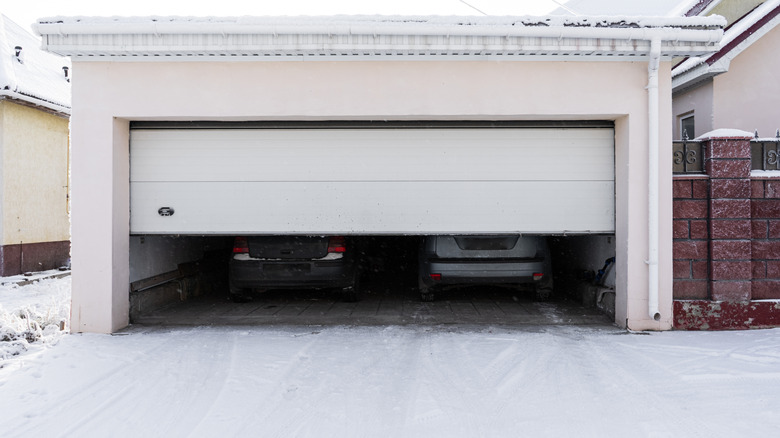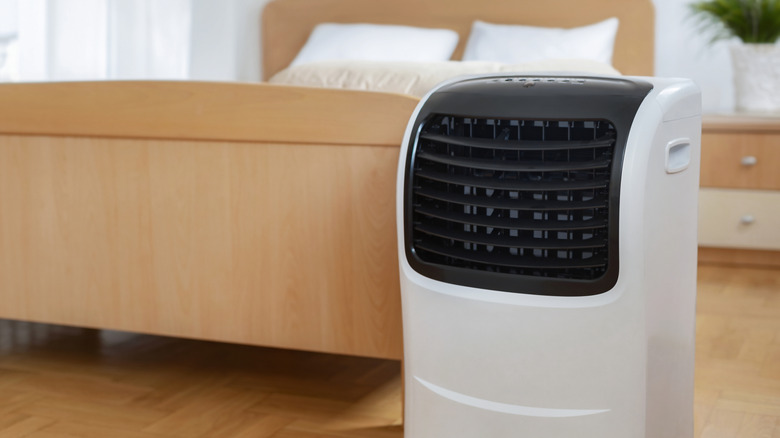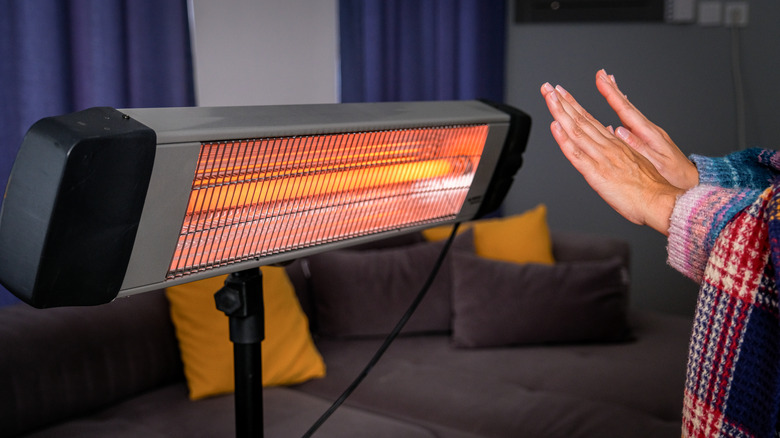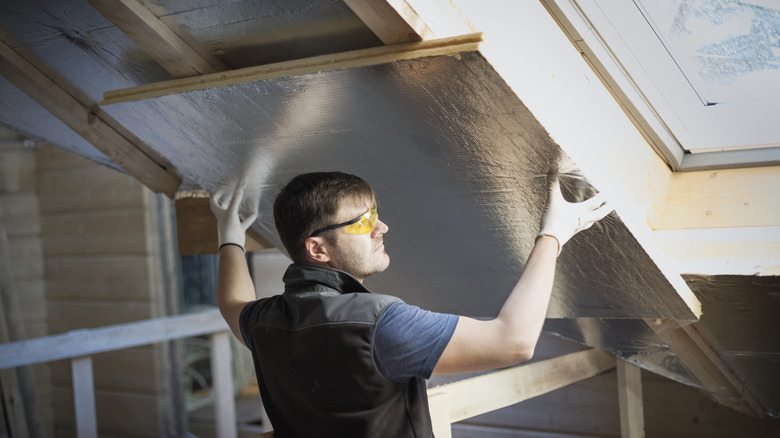The Best Ways To Heat Your Garage Without An Electric Space Heater
We may receive a commission on purchases made from links.
Oh, winter. While the snow makes it magical, it can quickly transform many areas in homes into uncomfortable spaces without the wonders of heating, including your garage. This practical workspace can turn into an uncomfortably cold area during freezing winters. Yes, many homeowners can use electric space heaters for a quick fix, but not everyone has access to one nor may they want to deal with the costs and limitations of using one. So, how can you warm up your garage during the winter?
Just because you don't have an electric space heater doesn't mean you need to surrender to the chill or avoid your garage during the colder months. The good news is that there are plenty of alternatives that can heat your garage just as — or even more — effectively than an electric space heater. These include heat pumps, infrared heaters, radiant heat panels, and more.
Space heating and air conditioning accounts for more than half of the annual energy consumption in American homes, making efficient heating solutions essential for homeowners. Letting the cold dictate how and when you can use your garage is a waste of potential. It is, after all, a valuable part of your home whether you use it for storage, as a workshop, or even as a home gym. With a little creativity and planning, you can make your garage a warm and functional space year-round.
Portable heat pump
A portable heat pump is an excellent option for heating your garage without relying on electric space heaters. Many models can be used for both heating and cooling, which means it is also perfect to cool down your garage during toasty summers. These work by transferring heat from one area to another. Because of this, portable heat pumps can reduce your electricity consumption for heating by up to 75% and may produce two to four times more heat energy than the electrical energy it uses. This makes them far more efficient than traditional electric heaters. Setup is also relatively easy, and they don't require permanent installation, making them easy to move around as needed.
While not as electricity-intensive as space heaters, a heat pump will still require power to operate. This can be a cause of concern if a homeowner is really trying to avoid electrical solutions entirely. The upside is that it costs less to use, leading to lower electricity bills. It's also important to know that the performance of a heat pump, especially a portable one, may not be at its peak in extremely cold climates. Just be ready to wait a little longer for your unit to extract enough heat from the surrounding air.
Passive solar heating
Passive solar heating is a great way to warm your garage using nothing but the power of the sun. You do this by installing south-facing thick windows or skylights and materials like concrete that store heat. This creates a system that absorbs sunlight to warm up the area, much like basking in a patch of warm carpet in front of a sunny window. This type of heating is a much greener, sustainable, and budget-friendly choice for your garage compared to traditional heating methods since it doesn't rely on electricity or fuel, meaning there will be no running energy costs once set up.
Passive solar heating does have its challenges that you should take into consideration. One is that it works best if your garage gets plenty of sunlight, and this might be difficult if you live in a cloudy or shaded area. Setting it up can be quite pricey and stressful, especially if you need to add windows, replace construction materials, or improve insulation. It's best to go this route when you're just planning your garage or when you're about to renovate your space. While passive solar heating may not be the best for every garage, it's still a smart and eco-friendly option when paired with good insulation or even a backup heating method.
Infrared heater
An infrared heater offers a unique method of warming spaces and is tagged by many as an increasingly better option than traditional heaters for garage heating. Instead of increasing the temperature of the air, these heaters emit far-infrared radiation that warms objects and people directly, making it very energy-efficient. It can lessen energy consumption by up to 50% compared to traditional heaters. One of the standout benefits of an infrared heater is its ability to deliver instant heat. You don't have to wait for the entire garage to warm up. You just need to position the heater where you're working, and you will feel the warmth immediately. Infrared heating also does not produce any smoke, condensation, or dust, making it a safer option for your garage.
An infrared heater works best in smaller spaces. This means that its ability to do its job may be compromised if your garage has poor insulation or drafty doors. And, since its heating effect is localized, you'll need to stay within the heater's range to stay warm. A way to get around this is to just position more than one infrared heater in your garage, especially if you are not working alone. An average one-car garage measures 12 feet wide and 20 feet long. This means that homeowners may need one or two infrared heaters to efficiently warm the entire space.
Radiant heat panels
Radiant heat panels are energy-efficient devices that can be mounted on or inside walls and ceilings or under floors. Like infrared heaters, they warm objects and people directly through surfaces rather than heating the air inside the space. The primary advantage of radiant heat panels is their sleek and discreet design. They take up no floor space and can be installed out of the way. This makes them a great option for smaller garages or those with limited space. They're also an environmentally friendly choice since they are silent and produce no emissions.
Radiant panels are a safe option to use for heating since the source of the heat is either hidden under the flooring or on the walls, away from any flammable materials present in your garage. On the downside, compared to other heating options for your garage in this list, radiant heat panels may be more expensive to purchase and install. And, while they provide consistent warmth, they may not be powerful enough to heat a large or poorly insulated garage on their own.
Better insulation
Sometimes, the best way to heat your garage isn't with a heating device at all. Many of the biting cold problems can be properly addressed with better insulation, which can make a significant difference in your garage's temperature just by keeping cold air out and warm air in. Making sure that you have good insulation in your garage offers several benefits.
For one, it is a one-time investment that improves energy efficiency throughout the year and not just in winter. Properly insulated walls, doors, and ceilings can also reduce the need for active heating altogether, thus saving you money in the long run. Though retrofitting insulation can be a time-consuming project if your garage is already finished or otherwise requires upfront effort and expense, the U.S. Environmental Protection Agency estimates that homeowners can save up to 15% on heating and cooling costs by properly sealing and installing insulation.
That said, insulation is best paired with a portable heating method for optimal results since it cannot generate heat on its own, only maintain the warmer environment. Heating your garage without an electric space heater is not only possible but practical. So don't let winter hold you back because of heating problems, just explore these options and reclaim your garage as a functional and comfortable part of your home no matter how cold it gets outside!



